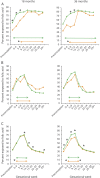Verbal abilities in children of mothers with epilepsy: Association to maternal folate status
- PMID: 30068633
- PMCID: PMC6133626
- DOI: 10.1212/WNL.0000000000006073
Verbal abilities in children of mothers with epilepsy: Association to maternal folate status
Abstract
Objective: To examine the effect of maternal folic acid supplementation and maternal plasma folate and antiepileptic drug (AED) concentrations on language delay in AED-exposed children of mothers with epilepsy.
Methods: Children of mothers with and without epilepsy enrolled from 1999 to 2008 in the Norwegian Mother and Child Cohort study were included. Information on medical history, AED use, and folic acid supplementation during pregnancy was collected from parent-completed questionnaires. Maternal plasma folate and maternal plasma and umbilical cord AED concentrations were measured in blood samples from gestational weeks 17 to 19 and immediately after birth, respectively. Language development at 18 and 36 months was evaluated by the Ages and Stages Questionnaires.
Results: A total of 335 AED-exposed children of mothers with epilepsy and 104,222 children of mothers without epilepsy were surveyed. For those with no maternal periconceptional folic acid supplementation, the fully adjusted odds ratio (OR) for language delay in AED-exposed children compared to the controls at 18 months was 3.9 (95% confidence interval [CI] 1.9-7.8, p < 0.001) and at 36 months was 4.7 (95% CI 2.0-10.6, p < 0.001). When folic supplementation was used, the corresponding ORs for language delay were 1.7 (95% CI 1.2-2.6, p = 0.01) and 1.7 (95% CI 0.9-3.2, p = 0.13), respectively. The positive effect of folic acid supplement use on language delay in AED-exposed children was significant only when supplement was used in the period from 4 weeks before the pregnancy and until the end of the first trimester.
Conclusion: Folic acid use early in pregnancy may have a preventive effect on language delay associated with in utero AED exposure.
Copyright © 2018 The Author(s). Published by Wolters Kluwer Health, Inc. on behalf of the American Academy of Neurology.
Figures


Similar articles
-
Association of Folic Acid Supplementation During Pregnancy With the Risk of Autistic Traits in Children Exposed to Antiepileptic Drugs In Utero.JAMA Neurol. 2018 Feb 1;75(2):160-168. doi: 10.1001/jamaneurol.2017.3897. JAMA Neurol. 2018. PMID: 29279889 Free PMC article.
-
Language impairment in children aged 5 and 8 years after antiepileptic drug exposure in utero - the Norwegian Mother and Child Cohort Study.Eur J Neurol. 2020 Apr;27(4):667-675. doi: 10.1111/ene.14140. Epub 2019 Dec 30. Eur J Neurol. 2020. PMID: 31814202
-
Early child development and exposure to antiepileptic drugs prenatally and through breastfeeding: a prospective cohort study on children of women with epilepsy.JAMA Neurol. 2013 Nov;70(11):1367-74. doi: 10.1001/jamaneurol.2013.4290. JAMA Neurol. 2013. PMID: 24061295
-
Long-term developmental outcome of children of women with epilepsy, unexposed or exposed prenatally to antiepileptic drugs: a meta-analysis of cohort studies.Drug Saf. 2010 Jan 1;33(1):73-9. doi: 10.2165/11317640-000000000-00000. Drug Saf. 2010. PMID: 20000869 Review.
-
Exposure to antiepileptic drugs in pregnancy: The need for a family factor framework.Epilepsy Behav. 2018 Sep;86:187-192. doi: 10.1016/j.yebeh.2018.06.043. Epub 2018 Jul 17. Epilepsy Behav. 2018. PMID: 30030084 Review.
Cited by
-
Folate fortification of food: Insufficient for women with epilepsy.Epilepsy Behav. 2021 Apr;117:107688. doi: 10.1016/j.yebeh.2020.107688. Epub 2021 Feb 23. Epilepsy Behav. 2021. PMID: 33636531 Free PMC article.
-
Folic Acid and Risk of Preterm Birth, Preeclampsia, and Fetal Growth Restriction Among Women With Epilepsy: A Prospective Cohort Study.Neurology. 2022 Aug 9;99(6):e605-e615. doi: 10.1212/WNL.0000000000200669. Epub 2022 May 16. Neurology. 2022. PMID: 35577577 Free PMC article.
-
Too Much of a Good Thing? High-Dose Folic Acid in Pregnancy and Childhood Cancer.Epilepsy Curr. 2023 Jan 23;23(2):102-104. doi: 10.1177/15357597221147357. eCollection 2023 Mar-Apr. Epilepsy Curr. 2023. PMID: 37122408 Free PMC article. No abstract available.
-
Pregnancy outcomes in women with epilepsy and MTHFR mutations supplemented with methylated folate and methylcobalamin (methylated B12).Epilepsy Behav Rep. 2020 Dec 17;15:100419. doi: 10.1016/j.ebr.2020.100419. eCollection 2021. Epilepsy Behav Rep. 2020. PMID: 33426516 Free PMC article.
-
Neurodevelopment Following Exposure to Antiseizure Medications in Utero: A Review.Curr Neuropharmacol. 2021;19(11):1825-1834. doi: 10.2174/1570159X19666210716111814. Curr Neuropharmacol. 2021. PMID: 34279202 Free PMC article. Review.
References
-
- McGarel C, Pentieva K, Strain JJ, McNulty H. Emerging roles for folate and related B-vitamins in brain health across the lifecycle. Proc Nutr Soc 2015;74:46–55. - PubMed
-
- Linnebank M, Moskau S, Semmler A, et al. . Antiepileptic drugs interact with folate and vitamin B12 serum levels. Ann Neurol 2011;69:352–359. - PubMed
-
- Belcastro V, Striano P, Gorgone G, et al. . Hyperhomocysteinemia in epileptic patients on new antiepileptic drugs. Epilepsia 2010;51:274–279. - PubMed
Publication types
MeSH terms
Substances
Grants and funding
LinkOut - more resources
Full Text Sources
Other Literature Sources
Medical
